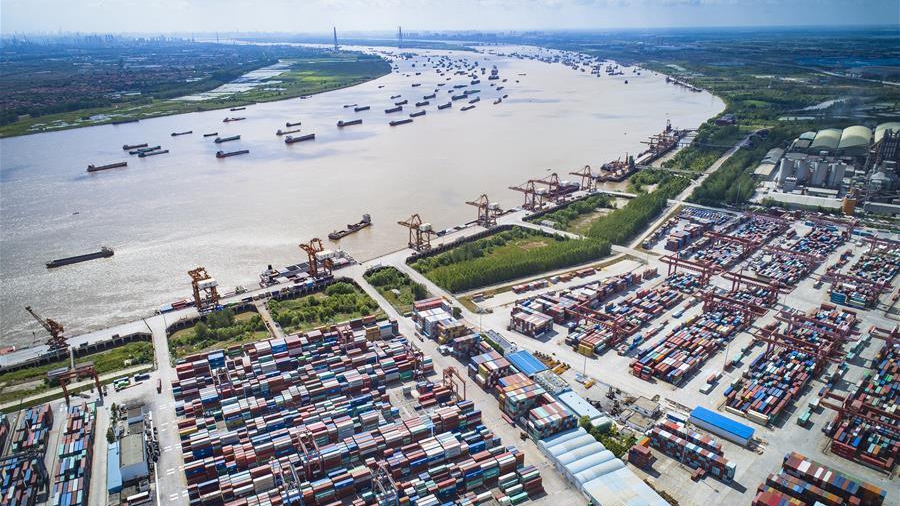
The Yangluo port, a major shopping center along the golden waterway of Yangtze River, in Wuhan, capital of central China's Hubei Province. /Xinhua
The Yangluo port, a major shopping center along the golden waterway of Yangtze River, in Wuhan, capital of central China's Hubei Province. /Xinhua
Editor's note: Hamzah Rifaat Hussain is a former visiting fellow at the Stimson Center in Washington, and currently serves as assistant researcher at the Islamabad Policy Research Institute (IPRI) in Pakistan. The article reflects the author's opinions, and not necessarily the views of CGTN.
On November 14th, Chinese President Xi Jinping called for further development of the 2016 Yangtze River Economic Belt (YREB) Development Plan which is based on Beijing's 'dual circulation strategy.'
The need to implement the YREB was necessitated over rising tensions with the Trump administration's pernicious trade policies, which took aim at China's local industries with the objective of puncturing economic growth.
Furthermore, China's reliance on U.S. high-tech products, such as semiconductors, means that domestic innovation and securing domestic supply chains became critical. The YREB, if developed as per the objectives of the CCP Central Committee Political Bureau, has the potential to promote great prosperity and self-reliance in the face of volatility of global financial markets and Washington D.C.'s economic strategies towards Beijing.
The YREB is based on 'dual circulation' and was raised by President Xi in May this year at a time when the Trump administration took specific aim at China's supply chains and move American production away from relying on China.
In addition, the pernicious effects of tariffs, requires that a holistic strategy towards sustainable economic growth be implemented.
The strategy itself hinges on both internal and external approaches with 'internal circulation' relating to the domestic cycle of China's production, dissemination, distribution and consumption for the Chinese population. External circulation on the other hand deals with supplementing the progress being witnessed in the previous stage.
This strategy has numerous benefits for China's development and would prevent it from getting embroiled in the vagaries of the global financial system.
The YREB also has the potential to act as a blueprint for rising powers as well as newly industrialized countries, which aim to promote greater domestic growth. The coordinated model guides the transfer of capital, technology, technological expertise and labor intensive industries in the Yangtze downstream to the upstream and midstream regions.
Countries such as Brazil, for example, which benefits from the Amazon River on its shores and seeks to boost its export capacity while avoiding global trading dynamics can utilize its geographical and strategic significance to transfer the large labor intensive industries in the country accordingly.

A ship sails in the Yangzhou section of the Yangtze River in Yangzhou, East China's Jiangsu Province, November 10, 2020. /Getty
A ship sails in the Yangzhou section of the Yangtze River in Yangzhou, East China's Jiangsu Province, November 10, 2020. /Getty
This becomes pertinent for countries burdened by high income inequality seeking to boost household incomes and consumption after being ravaged by the COVID-19 pandemic as well as glaring endemic poverty.
Key to the dual circulation strategy is also urbanization, which is a notable trend witnessed in newly industrialized countries across the world. Expansion of the middle class and the need to address income inequalities in BRICS states such as South Africa gives the dual circulation formula added resonance.
The domestic cycle has the potential to address the issue of recovery in consumption which has lagged behind production due to job losses and economic uncertainty due to the pandemic in China. Furthermore, boosting technological innovation and pushing indigenous firms up in the global value chain is another benefit that can be reaped under the dual circulation strategy adopted for the YREB.
Tapping into homegrown industries allows for greater export potential without having to adopt protectionist policies which reduce imports. That has the potential to cause great harm to indigenous firms which rely on imports for technology and raw materials.
External circulation on the other hand deals with exports, which allow for the solid industrial base to produce products that can compete globally. Countries that seek to minimize the effects of the pandemic on their current account balances can consider exports through the dual circulation strategy that combines a mixture of different tiers into a productive and growth leading economy.
The YREB project spans 11 Chinese provincial-level regions and covers 2.1 million square kilometers, constituting 21 percent of the land area of the third largest country in the world. It also covers 40 percent of the most populous country in the world in 2020, which currently has 18.47 percent of the world's population respectively. For countries at similar stages of development strategies akin to YREB have considerable geographical benefits as well.
The Yangtze River Economic Belt is in no way an import substitution model and takes due cognizance of a country's need to open to foreign direct investment. Many Chinese leaders have stressed on the need for the national economy to open up to attract investment in high end manufacturing, which will also strengthen its supply chain security.
The aim is to ensure that foreign companies and brands are not deterred from investing in China, that does not jeopardize its profile as an export-oriented, globalized and growth-centric country. It also vindicates China's position on countering environmental challenges in contrast to the Trump administration, where societal and economic issues alongside climate change can be addressed in a more holistic manner.
The one axis, two wings, three poles and multiple points development pattern published in March 2016 promises the setting up of a unified system for market entry, optimization of the financial system, and above all, forming competitive power. The YREB project really is a complete package for China and an ideal blueprint for countries to follow.
(If you want to contribute and have specific expertise, please contact us at opinions@cgtn.com.)

